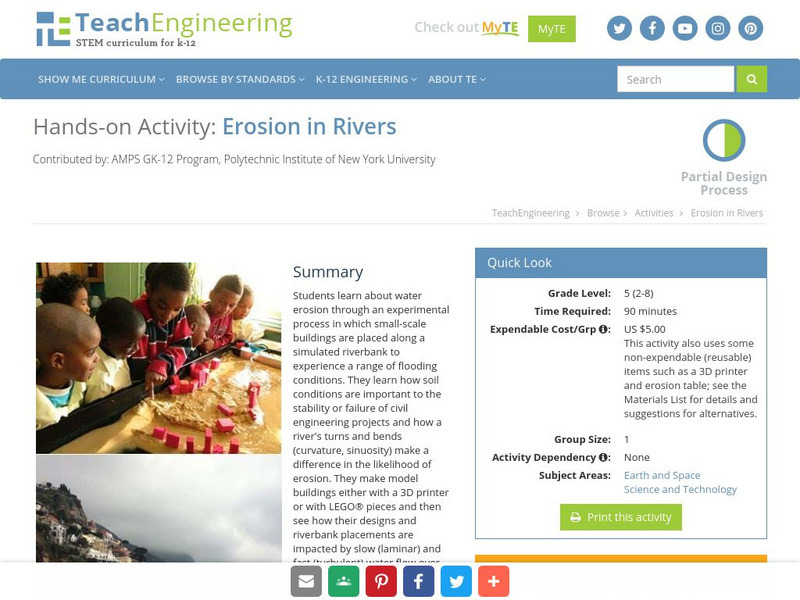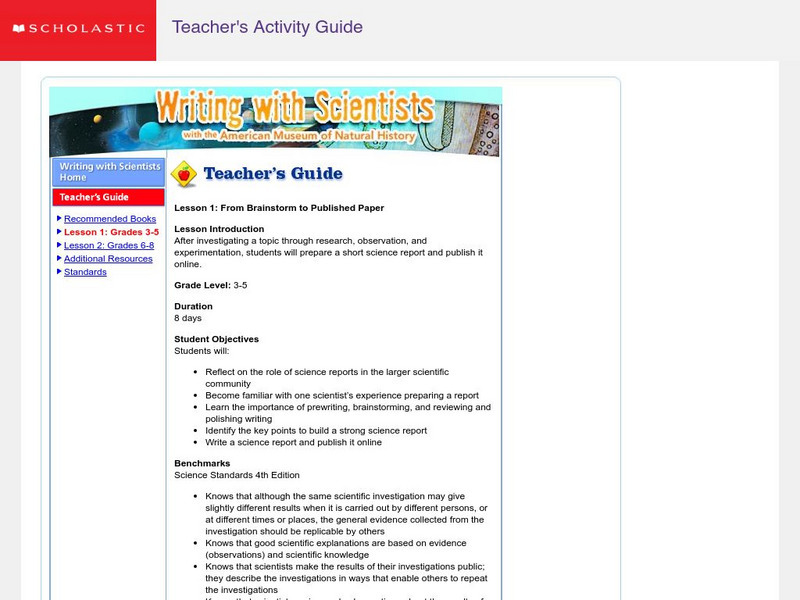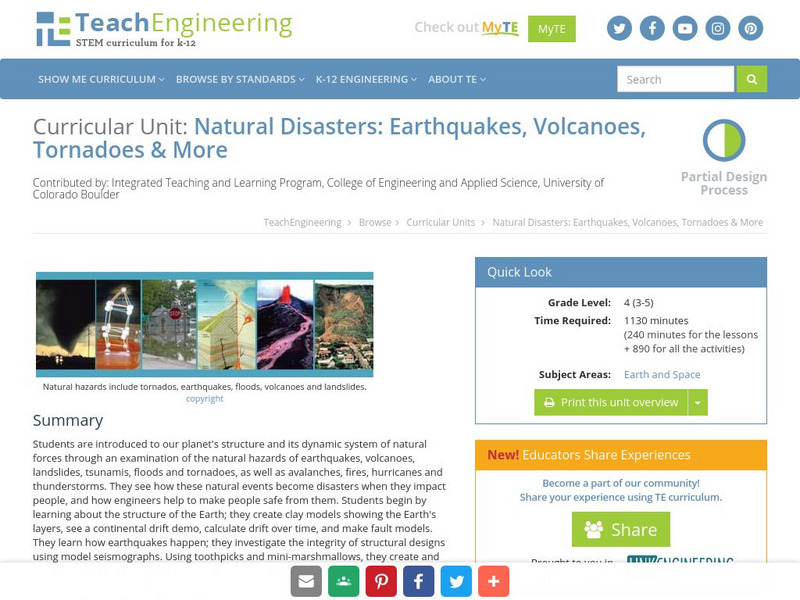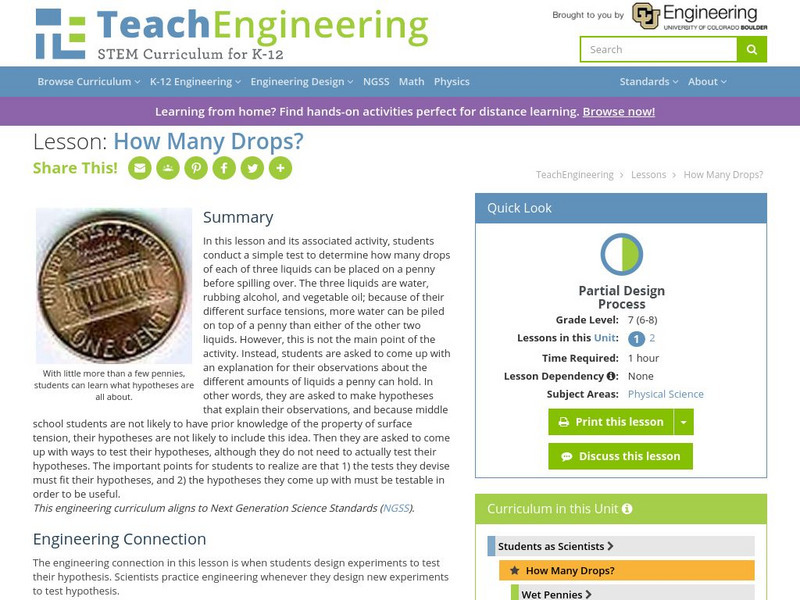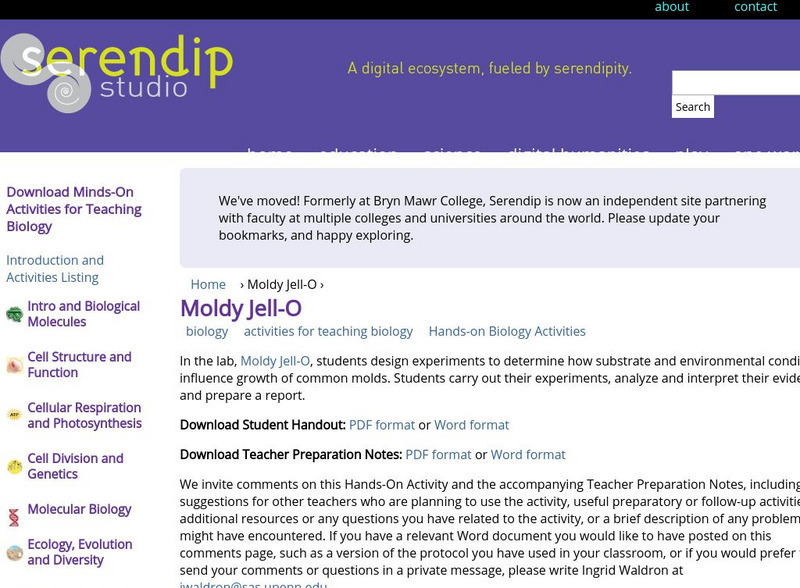Hi, what do you want to do?
TeachEngineering
Teach Engineering: Cell Membrane Experimental Design
The final activity of this unit, which integrates the Keepers of the Gate unit through the Go Public challenge, involves students taking part in experimental design. They design a lab that answers the challenge question: "You are...
TeachEngineering
Teach Engineering: Erosion in Rivers
Students learn about water erosion through an experimental process in which small-scale buildings are placed along a simulated riverbank to experience a range of flooding conditions. They make model buildings either with a 3D printer or...
Scholastic
Scholastic: Writing With Scientists
After students investigate a topic through research, hypothesizing, observing, and experimentating, teachers can use this lesson to help their students prepare short science reports and publish them online. The Writing with Scientists...
TeachEngineering
Teach Engineering: Natural Disasters
Students are introduced to our planet's structure and its dynamic system of natural forces through an examination of the natural hazards of earthquakes, volcanoes, landslides, tsunamis, floods and tornados, as well as avalanches, fires,...
TeachEngineering
Teach Engineering: How Many Drops?
In this lesson and its associated activity, students conduct a simple test to determine how many drops of each of three liquids can be placed on a penny before spilling over. The three liquids are water, rubbing alcohol, and vegetable...
TeachEngineering
Teach Engineering: Students as Scientists
This curricular unit contains two lessons that let students actually do the work of scientists as they design their own experiments to answer questions they generate. In the first lesson and its associated activity, students conduct a...
PBS
Pbs Kids: Dragonfly Tv Science Fair: Plan
So, you've chosen your topic and done your research, now, you need to plan your investigation. PBS site walks you through some steps to help guide you through the planning process.
Science Education Resource Center at Carleton College
Serc: Effectiveness of Mn Dams in Water Retention
Through this field activity, students will obtain hands-on experience by measuring stream flows and observing landform and stream processes of dams once before water freezes, and again after the weather deposition has occurred. Students...
Science Education Resource Center at Carleton College
Serc: Newton's 2nd Law: Inquiry Approach
In this activity, students test Isaac Newton's ideas on the nature of motion, in particular his 2nd Law. The emphasis is on the process of science, investigation, and experimentation, not the results. Students must come up with their own...
Climate Literacy
Clean: Uptake of Carbon Dioxide From Water by Plants
Two simple experimental demonstrations show the role of plants in mitigating the acidification caused when carbon dioxide is dissolved in water.
Bryn Mawr College
Serendip: Moldy Jell O
Brief text summary of what students learn in the Moldy Jell-O Lab along with links to download Student Handouts and Teacher Preparation Notes in PDF or Word formats. Students design the experiment and observe the growth of mold. Focus is...
Sophia Learning
Sophia: James Chadwick
This lesson explains the discovery of the neutron and Chadwick's experimental process.
Scientific American
Scientific American: Smart People Believe Weird Things
This article, published by Scientific American (September 2002), explores how smart people can believe weird and silly things. The article comes to the conclusion that our beliefs are shaped more by our environment than our understanding...
Michigan Reach Out
Michigan Reach Out: Creating a Salad Dressing
This site is provided for by Michigan Reach Out! Teach the scientific method with salad dressing! Students understand the scientific process and how it helps scientists by making salad dressing.
TeachEngineering
Teach Engineering: Android Acceleration
Students prepare for the associated activity in which they investigate acceleration by collecting acceleration vs. time data using the accelerometer of a sliding Android device. Based on the experimental set-up for the activity, students...
Texas Instruments
Texas Instruments: The Science of Racing
Turning the corners is the limiting process for racing cars. Going straight is simply about speed, but making the turns faster than other cars is a real challenge. In this activity, we ask how does weight balance affect the turn radius...
University of Washington
Washington U: Model for Conducting Scientific Research
This page outlines the scientific method, step by step.
McREL International
Mc Rel: Glue Polymer (Whelmer #15 Learning Activity)
An easy to do activity that investigates the basic principles behind chemical bonding. The activity is written in lesson plan format that meets NSES standards.






